Zoom
Trash

Practical. Nurturing. Motivating. The voice of dance educators. The key to your best dancing body is right under your skin.
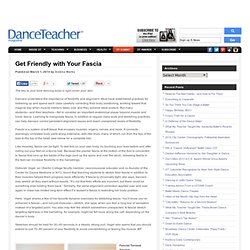
Dancers understand the importance of flexibility and alignment. Most have established practices for limbering up and spend each class carefully correcting their body positioning, working toward that magical day when muscle memory takes over and they achieve ideal posture. But many students—and their teachers—fail to consider an important anatomical player beyond muscle and bone: fascia. Learning to manipulate fascia, in addition to regular class work and stretching practices, can help dancers correct persistent alignment issues and reach unexplored levels of flexibility. Pointe magazine – Ballet at its Best. Total Body Tune-Up Thera-Band exercises that go beyond your toes.

Will Having Wide Feet Hinder My Ability To Do Pointe? Hi!
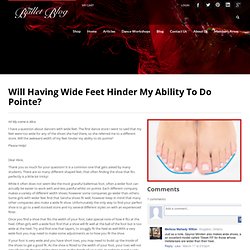
My name is Alice. I have a question about dancers with wide feet. The first dance store I went to said that my feet were too wide for any of the shoes she had there, so she referred me to a different store. Will the awkward width of my feet hinder my ability to do pointe? Please Help! Pointe magazine – Ballet at its Best. When it comes to jumping, dancers could learn a thing or two from athletes.
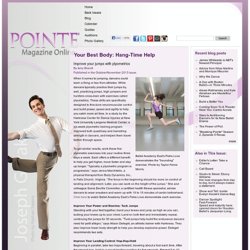
While dancers typically practice their jumps by, well, practicing jumps, high jumpers and hurdlers cross-train with exercises called plyometrics. These drills are specifically designed to fine-tune neuromuscular control and build power, speed and agility to help you catch more air time. In a study by the Harkness Center for Dance Injuries at New York University Langone Medical Center, a six-week plyometric training program improved both quadricep and hamstring strength in dancers, and helped them travel farther through space. To get similar results, work these five plyometric exercises into your routine three days a week.
Each offers a different benefit to help you get higher, move faster and stay up longer. Improve Your Push-Off Strength: Scissor JumpsStarting in parallel, jump and split the legs, with one foot moving front and the other back. How To Improve Your Jumps In Dance. Integrating Breathing into Dance, part 1: Your Diaphragm Probably Hates You. Or another potential title: Are you asking too much of your diaphragm?
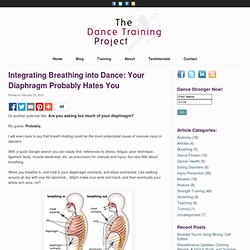
My guess: Probably. I will even dare to say that breath-holding could be the most underrated cause of overuse injury in dancers. With a quick Google search you can easily find references to stress, fatigue, poor technique, ligament laxity, muscle weakness, etc. as precursors for overuse and injury, but very little about breathing. A Teacher’s Guide to Helping Young Dancers Cope with Psychological Aspects of Hip Injuries - By Lynda Mainwaring, Ph.D., C.Psych., Donna Krasnow, M.S., and Lauren Young. Pointe magazine – Ballet at its Best. First, the good news: Ballet does not cause bunions directly.
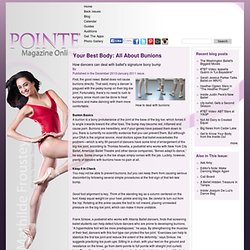
That said, many a dancer is plagued with the pesky bump on their big-toe joint. Fortunately, there’s no need to rush to surgery, since much can be done to treat bunions and make dancing with them more comfortable. Bunion BasicsA bunion is a bony protuberance of the joint at the base of the big toe, which forces it to angle inwards toward the other toes.
The bump may become red, inflamed and cause pain. Tips for Turnout - Achieving Your Ultimate Range. It seems like the flavour of the month in the clinic this month is turnout.
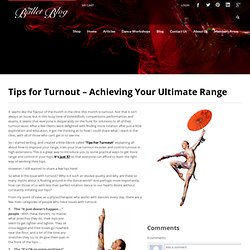
Not that it isn’t always an issue, but in this busy time of Eisteddfods, competitions performances and exams, it seems that everyone is desperately on the hunt for solutions to all of their turnout woes. Pointe magazine – Ballet at its Best. Sometimes, the healthiest-sounding nutrition tips are simply myths.
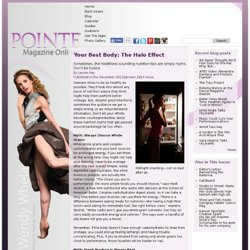
Don’t be fooled. Dancers strive to be as healthy as possible. They’ll look into almost any piece of nutrition advice they think might help them perform better onstage. But, despite good intentions, sometimes the guidance we get is simply wrong, or we misunderstand information. Don’t let your efforts become counterproductive: Avoid these nutrition myths that get passed around backstage far too often. Myth: Always Choose Whole GrainsWhile whole grains and complex carbohydrates are your best sources for prolonged energy, if you eat them at the wrong time, they might not help your dancing.
Remember, if the body doesn’t have enough carbohydrates to draw from onstage, you could end up feeling lethargic and having trouble concentrating. How Ballet Dancers Can Avoid Common Foot Injuries. Most dancers will complain of some foot injury at some stage in their training, and professional ballet dancers will often be plagued with chronic foot injuries, ranging from mild ones that are nursed for years, to severe injuries that may be career ending.
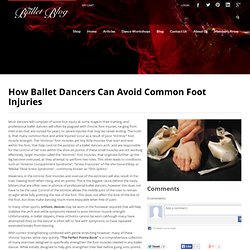
The truth is, that many common foot and ankle ‘injuries’ occur as a result of poor “intrinsic” foot muscle strength. The “intrinsic” foot muscles are tiny little muscles that start and end within the foot, that help control the position of a ballet dancers arch, and are responsible for the control of her toes within the shoe en pointe. If these small muscles are not working effectively, larger muscles called the “extrinsic” foot muscles, that originate further up the leg become overused, as they attempt to perform two roles. This often leads to conditions such as “Anterior Compartment Syndrome”, “Stress Fractures” of the shin bone (tibia), or ‘Medial Tibial Stress Syndrome” , commonly known as “Shin Splints”.
Pointe magazine – Ballet at its Best. During her first semester with Columbia Ballet Collaborative, Rachel Silvern surprised herself.
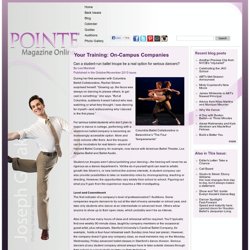
“Growing up, the focus was always on dancing to please others, to get cast in something,” she says. “But at Columbia, suddenly it wasn’t about who was watching or what they thought. I was dancing for myself—and rediscovering why I danced in the first place.” For serious ballet students who don’t plan to major in dance in college, performing with a student-run ballet company is becoming an increasingly accessible option. More and more schools offer them. Student-run troupes aren’t about polishing your dancing—the training will never be as rigorous as a dance department’s. Teaching the Dance Class: Strategies to Enhance Skill Acquisition, Mastery and Positive Self-Image - By Lynda M. Mainwaring and Donna H. Krasnow.
Dance Magazine – If it's happening in the world of dance, it's happening in Dance Magazine. By Joseph Carman How can we bring batterie back to its former glory? Maxim Beloserkovsky teaching pre-professional men’s class at Ballet Academy East. Pointe magazine – Ballet at its Best. My teacher said that I could three-quarter my pointe shoes to make it easier to get right on the box, but I’m not sure how. I’m afraid that I might ruin my shoes. —Doireann Three-quartering pointe shoes is easy, but does take some practice. Try it on an old pair first so that it’s not a complete waste if you make a mistake. Dancers don’t end up on the dole … and for that reason, I’m IN. Collaborate.Produce.Inspire. November 2, 2013Phil Sanger OK, so this is possibly a rather large generalisation but I am prepared to get political and stick my neck on the line for this one.
Based on the amount of dancers I know and the amount of time I have worked in the arts and entertainment industry I can say that I don’t know anyone who ‘works’ in the unemployment line, I’m talking chronic unemployment here. Having broached the subject with a number of people I am still waiting to be proven wrong. The only dance trained people I encountered who are living on any sort of benefits were the ones who had become parents or injured and as a matter of fact they really didn’t want to be unemployed and didn’t particularly want it to be discussed publically.